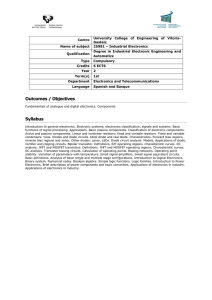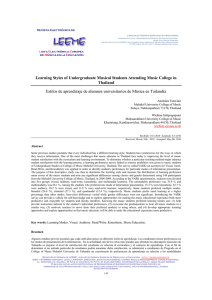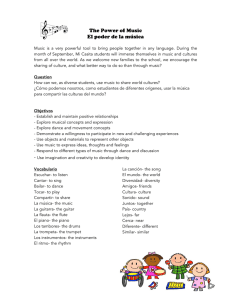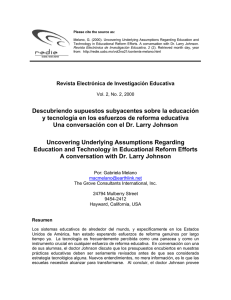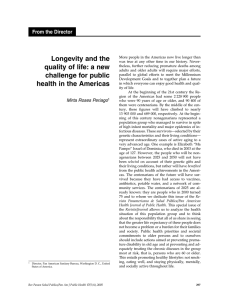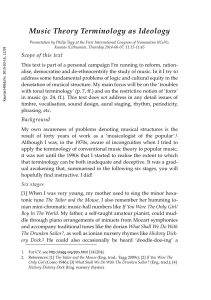Lista Europea Electrónica de Música en
Anuncio
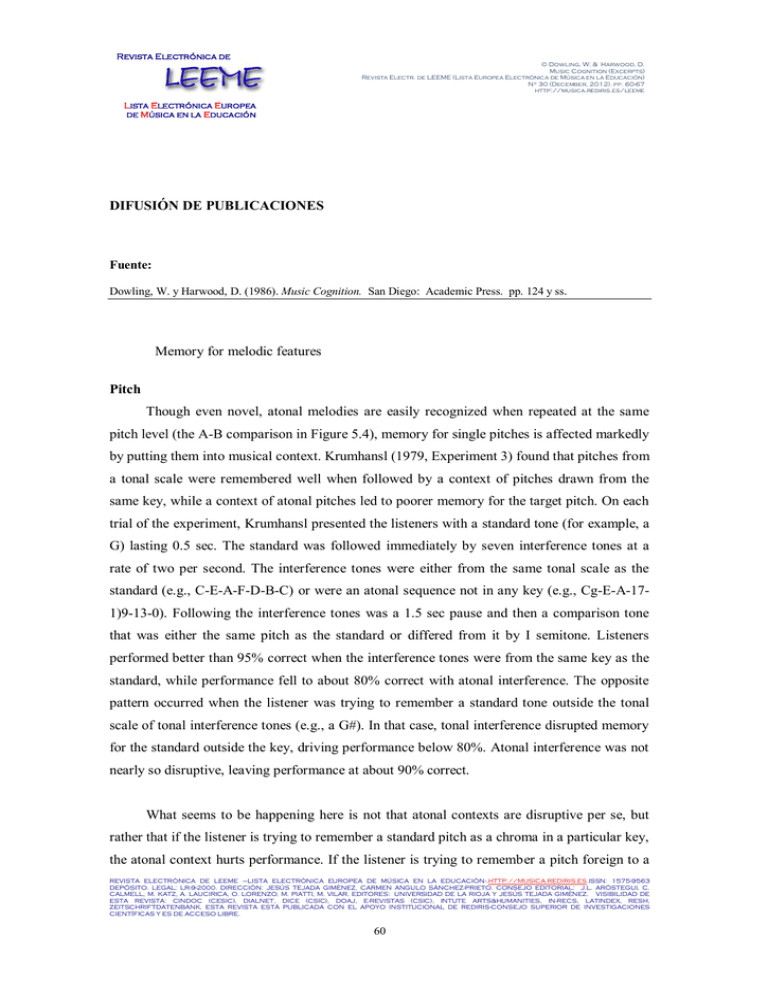
Revista Electrónica de © Dowling, W. & Harwood, D. Music Cognition (Excerpts) Revista Electr. de LEEME (Lista Europea Electrónica de Música en la Educación) Nº 30 (December, 2012). pp. 60-67 http://musica.rediris.es/leeme Lista Electrónica Europea de Música en la Educación DIFUSIÓN DE PUBLICACIONES Fuente: Dowling, W. y Harwood, D. (1986). Music Cognition. San Diego: Academic Press. pp. 124 y ss. Memory for melodic features Pitch Though even novel, atonal melodies are easily recognized when repeated at the same pitch level (the A-B comparison in Figure 5.4), memory for single pitches is affected markedly by putting them into musical context. Krumhansl (1979, Experiment 3) found that pitches from a tonal scale were remembered well when followed by a context of pitches drawn from the same key, while a context of atonal pitches led to poorer memory for the target pitch. On each trial of the experiment, Krumhansl presented the listeners with a standard tone (for example, a G) lasting 0.5 sec. The standard was followed immediately by seven interference tones at a rate of two per second. The interference tones were either from the same tonal scale as the standard (e.g., C-E-A-F-D-B-C) or were an atonal sequence not in any key (e.g., Cg-E-A-171)9-13-0). Following the interference tones was a 1.5 sec pause and then a comparison tone that was either the same pitch as the standard or differed from it by I semitone. Listeners performed better than 95% correct when the interference tones were from the same key as the standard, while performance fell to about 80% correct with atonal interference. The opposite pattern occurred when the listener was trying to remember a standard tone outside the tonal scale of tonal interference tones (e.g., a G#). In that case, tonal interference disrupted memory for the standard outside the key, driving performance below 80%. Atonal interference was not nearly so disruptive, leaving performance at about 90% correct. What seems to be happening here is not that atonal contexts are disruptive per se, but rather that if the listener is trying to remember a standard pitch as a chroma in a particular key, the atonal context hurts performance. If the listener is trying to remember a pitch foreign to a REVISTA ELECTRÓNICA DE LEEME –LISTA ELECTRÓNICA EUROPEA DE MÚSICA EN LA EDUCACIÓN-.HTTP://MUSICA.REDIRIS.ES.ISSN: 1575-9563 DEPÓSITO. LEGAL: LR-9-2000. DIRECCIÓN: JESÚS TEJADA GIMÉNEZ, CARMEN ANGULO SÁNCHEZ-PRIETO. CONSEJO EDITORIAL: J.L. ARÓSTEGUI, C. CALMELL, M. KATZ, A. LAUCIRICA, O. LORENZO, M. PIATTI, M. VILAR. EDITORES: UNIVERSIDAD DE LA RIOJA Y JESÚS TEJADA GIMÉNEZ. VISIBILIDAD DE ESTA REVISTA: CINDOC (CESIC), DIALNET, DICE (CSIC), DOAJ, E-REVISTAS (CSIC), INTUTE ARTS&HUMANITIES, IN-RECS, LATINDEX, RESH, ZEITSCHRIFTDATENBANK, ESTA REVISTA ESTÁ PUBLICADA CON EL APOYO INSTITUCIONAL DE REDIRIS-CONSEJO SUPERIOR DE INVESTIGACIONES CIENTÍFICAS Y ES DE ACCESO LIBRE. 60 Revista Electrónica de © Dowling, W. & Harwood, D. Music Cognition (Excerpts) Revista Electr. de LEEME (Lista Europea Electrónica de Música en la Educación) Nº 30 (December, 2012). pp. 60-67 http://musica.rediris.es/leeme Lista Electrónica Europea de Música en la Educación key, then a context drawn from that key is disruptive and the atonal context is not. The tonal context appears to cause a shift in the listener's internal frame of reference when the interpolated tones are drawn from a different set than the one that incorporates the standard tone. This interpretation was explored further in work done by Kirk Blackburn in Dowling's laboratory. Blackburn used two types of tonal context rather than tonal and atonal and made the listener's task more difficult than Krumhansl's by asking listeners to imagine the standard tone. In other respects, the procedure was very similar to Krumhansl's. To aid the listener's imagination, Blackburn played part of a major scale leading up or down to the tonic (e.g., GA-B or F-E-D), leaving it to the listener to imagine its completion (in this case, Q. Five interference tones followed, either from the same key as the target (e.g., G-A-D-E-F) or from a distant key (B or F# major, e.g., F#-G#-A#-D#-F#). The comparison tone was either the imagined target (C) or a semitone removed from it (B or C#). When the interpolated tones were in the same key as the imagined tonic and its scale, performance was around 75% correct. When the interpolated tones suggested a different key, performance was worse than chance-around 40%. The interpretation that distant-key interference caused a shift in the listener's schematic frame of reference is supported by the pattern of errors when the comparison tone differed from the imagined tonic C. The B could have come from either C major or the distant key (B major or F# major). The C#, however, could have come only from the distant key. Falsepositive recognitions of the B were about equal for the two types of interference, while false positives for the C# were primarily the result of distant-key interference. The C# sounded very natural when it followed a series of tones with which it could combine in a major scale, whereas it sounded strange and was easy to reject when it followed the C-major scale to which it was foreign. Memory for a pitch can be altered by contextual shifts other than those involved in the tonal structure. Pitch shifts of notes in brief atonal melodies affect memory for the pitch of neighboring notes. Guilford and Hilton (1933) used pairs of melodies from Seashore's (1919) test of melodic memory. The pitch of one note of the melody was changed upon repetition. Listeners reported hearing changes not only in the actually altered tones, but also shifts (in the REVISTA ELECTRÓNICA DE LEEME –LISTA ELECTRÓNICA EUROPEA DE MÚSICA EN LA EDUCACIÓN-.HTTP://MUSICA.REDIRIS.ES.ISSN: 1575-9563 DEPÓSITO. LEGAL: LR-9-2000. DIRECCIÓN: JESÚS TEJADA GIMÉNEZ, CARMEN ANGULO SÁNCHEZ-PRIETO. CONSEJO EDITORIAL: J.L. ARÓSTEGUI, C. CALMELL, M. KATZ, A. LAUCIRICA, O. LORENZO, M. PIATTI, M. VILAR. EDITORES: UNIVERSIDAD DE LA RIOJA Y JESÚS TEJADA GIMÉNEZ. VISIBILIDAD DE ESTA REVISTA: CINDOC (CESIC), DIALNET, DICE (CSIC), DOAJ, E-REVISTAS (CSIC), INTUTE ARTS&HUMANITIES, IN-RECS, LATINDEX, RESH, ZEITSCHRIFTDATENBANK, ESTA REVISTA ESTÁ PUBLICADA CON EL APOYO INSTITUCIONAL DE REDIRIS-CONSEJO SUPERIOR DE INVESTIGACIONES CIENTÍFICAS Y ES DE ACCESO LIBRE. 61 Revista Electrónica de © Dowling, W. & Harwood, D. Music Cognition (Excerpts) Revista Electr. de LEEME (Lista Europea Electrónica de Música en la Educación) Nº 30 (December, 2012). pp. 60-67 http://musica.rediris.es/leeme Lista Electrónica Europea de Música en la Educación same direction) of neighboring tones that had not been altered. In a second study, Guilford and Nelson (1936) repeated melodies without altering any pitches, and listeners still reported hearing pitch shifts. (The atonality of the melodies probably contributed to the difficulty of accurate pitch judgment.) Guilford and Nelson (1937) simplified the task by using three-note melodies containing pairs of identical or adjacent pitches, plus another note separated in pitch from the pair. The three notes could occur in any order, and the listener's task was to say whether the second note of the similar pair was the same as, or higher or lower than, the first. Guilford and Nelson found that the second note of the pair tended to be shifted away from the note that was different in pitch. For example, in the sequence C#-G-C# (with the G higher) the second CO was judged lower in pitch than the first. It is as though the listener's internal standard for the pitch CO had been shifted upward by the occurrence of the G, and the second (actual) CO judged flat by comparison. Dewar, Cuddy, and Mewhort (1977) provide further evidence of the importance of a tonal scale schema in memory for pitch. They presented listeners with seven-note sequences that were either tonal or atonal. Then they presented a pair of tones, one of which had occurred in the original sequence, and asked the listeners to tell which tone they had heard before. Performance was better with tonal sequences than with atonal (81% vs. 77%). Dewar et al. also included a condition in which the comparison stimuli consisted of the whole seven-note sequences, either intact or with one note changed. Listeners found this task much easier, achieving 99% correct with tonal sequences and 91% with atonal. We can conclude two things from this: (1) The additional information in the whole sequence was useful in judging the accuracy of the single pitch, and (2) this information was especially useful with tonal sequences. In an extension of this line of work Cuddy, Cohen, and Miller (1979) tested memory for tonal three-note fragments. Listeners were supposed to notice a change in one note of a fragment when it was presented and tested in isolation, or with the addition of a context of two preceding and two following notes. The altered note either remained within the tonal scale of the other notes or departed from it. In comparison to detection of note changes in the fragment alone, addition of a strongly tonal context led to significantly better detection of alterations REVISTA ELECTRÓNICA DE LEEME –LISTA ELECTRÓNICA EUROPEA DE MÚSICA EN LA EDUCACIÓN-.HTTP://MUSICA.REDIRIS.ES.ISSN: 1575-9563 DEPÓSITO. LEGAL: LR-9-2000. DIRECCIÓN: JESÚS TEJADA GIMÉNEZ, CARMEN ANGULO SÁNCHEZ-PRIETO. CONSEJO EDITORIAL: J.L. ARÓSTEGUI, C. CALMELL, M. KATZ, A. LAUCIRICA, O. LORENZO, M. PIATTI, M. VILAR. EDITORES: UNIVERSIDAD DE LA RIOJA Y JESÚS TEJADA GIMÉNEZ. VISIBILIDAD DE ESTA REVISTA: CINDOC (CESIC), DIALNET, DICE (CSIC), DOAJ, E-REVISTAS (CSIC), INTUTE ARTS&HUMANITIES, IN-RECS, LATINDEX, RESH, ZEITSCHRIFTDATENBANK, ESTA REVISTA ESTÁ PUBLICADA CON EL APOYO INSTITUCIONAL DE REDIRIS-CONSEJO SUPERIOR DE INVESTIGACIONES CIENTÍFICAS Y ES DE ACCESO LIBRE. 62 Revista Electrónica de © Dowling, W. & Harwood, D. Music Cognition (Excerpts) Revista Electr. de LEEME (Lista Europea Electrónica de Música en la Educación) Nº 30 (December, 2012). pp. 60-67 http://musica.rediris.es/leeme Lista Electrónica Europea de Música en la Educación that departed from the tonal scale. Addition of an atonal context led to worse performance in the detection of alterations whether within the tonal scale or not. The effects of context depend on the degree to which context invokes the listener's scale schemata, a point to which we return below. In summary, we have seen that the context in which a pitch is heard affects memory for that pitch, and in particular, that tonal scale context can aid in memory for context-compatible pitches and aid in the detection of incompatible ones. Contexts that include pitches outside the scale schema of an inferred tonal scale can interfere with accurate memory and cause systematic errors of judgment. A practical application of this principle is found in choral singing. When a section of a chorus has several measures rest, reentry on the correct pitch is often facilitated by the reentry pitch's being the same as the last pitch sung. As long as the piece stays in the same key during the rest, choristers remember the pitch well. However, if the piece modulates to a new key the entrance is more difficult, even though the pitch is the same. In the broader scheme of remembering music, remembering a melody involves more than just remembering a series of unrelated pitches. Melodies have global features that pertain to the whole pattern, and one of these is contour. We now turn to a discussion of memory for melodic contour. Contour Contour refers to the pattern of ups and downs of pitch from note to note in a melody. The importance of contour in recognition is disclosed in experiments in which comparison melodies sharing the same contour as the original (such as those in Figure 5.4C, D, and E) are easily distinguished from those that do not (as in Figure 5.4F). The relative importance of contour in comparison to other features of melodies is shown by the degree to which the (C-DE) versus (F) discrimination is strong and the discriminations among melodies like (C), (D), and (E) (that differ among themselves in other features such as pitch intervals and tonality) are weak. Contour is an especially important feature of melodies in immediate recognition where the exact relationship between a melody and the scale schema has not been thoroughly REVISTA ELECTRÓNICA DE LEEME –LISTA ELECTRÓNICA EUROPEA DE MÚSICA EN LA EDUCACIÓN-.HTTP://MUSICA.REDIRIS.ES.ISSN: 1575-9563 DEPÓSITO. LEGAL: LR-9-2000. DIRECCIÓN: JESÚS TEJADA GIMÉNEZ, CARMEN ANGULO SÁNCHEZ-PRIETO. CONSEJO EDITORIAL: J.L. ARÓSTEGUI, C. CALMELL, M. KATZ, A. LAUCIRICA, O. LORENZO, M. PIATTI, M. VILAR. EDITORES: UNIVERSIDAD DE LA RIOJA Y JESÚS TEJADA GIMÉNEZ. VISIBILIDAD DE ESTA REVISTA: CINDOC (CESIC), DIALNET, DICE (CSIC), DOAJ, E-REVISTAS (CSIC), INTUTE ARTS&HUMANITIES, IN-RECS, LATINDEX, RESH, ZEITSCHRIFTDATENBANK, ESTA REVISTA ESTÁ PUBLICADA CON EL APOYO INSTITUCIONAL DE REDIRIS-CONSEJO SUPERIOR DE INVESTIGACIONES CIENTÍFICAS Y ES DE ACCESO LIBRE. 63 Revista Electrónica de © Dowling, W. & Harwood, D. Music Cognition (Excerpts) Revista Electr. de LEEME (Lista Europea Electrónica de Música en la Educación) Nº 30 (December, 2012). pp. 60-67 http://musica.rediris.es/leeme Lista Electrónica Europea de Música en la Educación established, as well as with atonal melodies in which there is no scale schema to relate the melody to. The dominance of contour in the immediate recognition of atonal melodies is illustrated in a study by Dowling and Fujitani (197 1, Experiment 1). They presented listeners with pairs of five-note atonal melodies like those shown in Figure 5.5. Figure 5.5 Atonal melodies like those used by Dowling and Fujitani (1971, Experiment 1): (A) exact transposition, (B) same-contour imitation, and (C) different-contour comparison. The comparison melody was either an exact transposition of the original to a new pitch level (Figure 5.5A), an imitation of the original that preserved contour but not interval sizes (Figure 5.513), or a comparison with a different contour (Figure 5.5Q. Listeners found it relatively easy to distinguish between either transpositions (A) or contour-preserving imitations (B) and the different-contour melodies (C), achieving between 85% and 90% correct. Listeners found it almost impossible to distinguish between transpositions (A) and same-contour imitations (B), however, performing at around the chance level of 50%. It appears that these listeners, who had at most only moderate amounts of musical training, based their judgments almost entirely on contour similarity and were unable to detect changes in interval sizes in these atonal melodies. In a similar experiment Francès (1958, Experiment 9) asked listeners to distinguish transpositions of brief melodies from same-contour imitations. Listeners found the task much REVISTA ELECTRÓNICA DE LEEME –LISTA ELECTRÓNICA EUROPEA DE MÚSICA EN LA EDUCACIÓN-.HTTP://MUSICA.REDIRIS.ES.ISSN: 1575-9563 DEPÓSITO. LEGAL: LR-9-2000. DIRECCIÓN: JESÚS TEJADA GIMÉNEZ, CARMEN ANGULO SÁNCHEZ-PRIETO. CONSEJO EDITORIAL: J.L. ARÓSTEGUI, C. CALMELL, M. KATZ, A. LAUCIRICA, O. LORENZO, M. PIATTI, M. VILAR. EDITORES: UNIVERSIDAD DE LA RIOJA Y JESÚS TEJADA GIMÉNEZ. VISIBILIDAD DE ESTA REVISTA: CINDOC (CESIC), DIALNET, DICE (CSIC), DOAJ, E-REVISTAS (CSIC), INTUTE ARTS&HUMANITIES, IN-RECS, LATINDEX, RESH, ZEITSCHRIFTDATENBANK, ESTA REVISTA ESTÁ PUBLICADA CON EL APOYO INSTITUCIONAL DE REDIRIS-CONSEJO SUPERIOR DE INVESTIGACIONES CIENTÍFICAS Y ES DE ACCESO LIBRE. 64 Revista Electrónica de © Dowling, W. & Harwood, D. Music Cognition (Excerpts) Revista Electr. de LEEME (Lista Europea Electrónica de Música en la Educación) Nº 30 (December, 2012). pp. 60-67 http://musica.rediris.es/leeme Lista Electrónica Europea de Música en la Educación harder with atonal than with tonal melodies, suggesting that they did not succeed in remembering the intervals between the notes in the atonal melodies and were confused by imitations that had similar intervals. In that case, contour was the dominant feature. Francès' study had the virtue of using more natural sounding melodies than most studies in this areamelodies having interesting rhythmic patterns. Though Francès' study had the limitation of using only four different melodies over and over again, the fact that its results converge closely with other findings leads us to have confidence in them. We return below to the role of tonal scale schemata in melodic memory. For the present, it seems clear that contour is an especially important feature in the recognition of atonal melodies. Contour is also important in the immediate recognition of novel melodies in cases where the tonal scale framework remains constant. Dowling (1978b) replicated Dowling and Fujitani's (1971) experiment, but this time used tonal melodies. Figure 5.6 illustrates the types of comparison melodies in this study. Note that the tonal imitation (C) remains in the tonal key of the original; that is, it is constructed from notes of the same tonal scale. Comparison (C) preserves the same diatonic intervals (measured along the tonal scale) as (A) while altering the chromatic intervals. Listeners were unable to distinguish between (A)-(B) pairs and (A)-(C) pairs in this experiment, showing that contour is the dominant feature in those comparisons. Example 5n presents first an (A)-(B) pair and then an (A)-(C) pair so that you can hear how similar the (A)-(C) melodies sound. The data are shown in Table 5.1 along with the corresponding condition of Dowling and Fujitani's experiment. Discrimination between transpositions and same-contour tonal imitations is around the chance level of 50%, while REVISTA ELECTRÓNICA DE LEEME –LISTA ELECTRÓNICA EUROPEA DE MÚSICA EN LA EDUCACIÓN-.HTTP://MUSICA.REDIRIS.ES.ISSN: 1575-9563 DEPÓSITO. LEGAL: LR-9-2000. DIRECCIÓN: JESÚS TEJADA GIMÉNEZ, CARMEN ANGULO SÁNCHEZ-PRIETO. CONSEJO EDITORIAL: J.L. ARÓSTEGUI, C. CALMELL, M. KATZ, A. LAUCIRICA, O. LORENZO, M. PIATTI, M. VILAR. EDITORES: UNIVERSIDAD DE LA RIOJA Y JESÚS TEJADA GIMÉNEZ. VISIBILIDAD DE ESTA REVISTA: CINDOC (CESIC), DIALNET, DICE (CSIC), DOAJ, E-REVISTAS (CSIC), INTUTE ARTS&HUMANITIES, IN-RECS, LATINDEX, RESH, ZEITSCHRIFTDATENBANK, ESTA REVISTA ESTÁ PUBLICADA CON EL APOYO INSTITUCIONAL DE REDIRIS-CONSEJO SUPERIOR DE INVESTIGACIONES CIENTÍFICAS Y ES DE ACCESO LIBRE. 65 Revista Electrónica de © Dowling, W. & Harwood, D. Music Cognition (Excerpts) Revista Electr. de LEEME (Lista Europea Electrónica de Música en la Educación) Nº 30 (December, 2012). pp. 60-67 http://musica.rediris.es/leeme Lista Electrónica Europea de Música en la Educación discrimination between transpositions and different-contour melodies is better than 80%. Notice that while Dowling and Fujitani's listeners could not distinguish transpositions from imitations where both were atonal, Dowling's (1978b) listeners could do so at better than chance levels where the transposition is tonal and the imitation atonal. Tonality itself can be used as a cue, and naturally enough, the more experienced listeners were better at using it (79% vs. 59%). Figure 5.6 Tonal melodies used by Dowling (1978b): (A) initial melody of trial, (B) exact transposition, (C) tonal imitation with different intervals, (D) atonal imitation with different intervals and pitches outside tonal scale, and (E) different-contour melody. We return to this study in our discussion of tonality, but for present purposes, it is clear that listeners have difficulty discriminating tonal imitations in the same key from transpositions and that this leaves contour the dominant melodic feature in determining the listeners' responses. Contour is an important feature in the recognition of familiar melodies. White (1960) and Dowling and Fujitani (1971, Experiment 2) demonstrated that listeners can recognize distorted versions of familiar tunes in which the pitch intervals between notes are changed while the contours are preserved. Dowling and Fujitani used a set of tunes of which the first two phrases could be regularized into the same rhythm, thus eliminating rhythmic pattern as a cue. Undistorted versions of these tunes were recognized almost perfectly, while distortions in REVISTA ELECTRÓNICA DE LEEME –LISTA ELECTRÓNICA EUROPEA DE MÚSICA EN LA EDUCACIÓN-.HTTP://MUSICA.REDIRIS.ES.ISSN: 1575-9563 DEPÓSITO. LEGAL: LR-9-2000. DIRECCIÓN: JESÚS TEJADA GIMÉNEZ, CARMEN ANGULO SÁNCHEZ-PRIETO. CONSEJO EDITORIAL: J.L. ARÓSTEGUI, C. CALMELL, M. KATZ, A. LAUCIRICA, O. LORENZO, M. PIATTI, M. VILAR. EDITORES: UNIVERSIDAD DE LA RIOJA Y JESÚS TEJADA GIMÉNEZ. VISIBILIDAD DE ESTA REVISTA: CINDOC (CESIC), DIALNET, DICE (CSIC), DOAJ, E-REVISTAS (CSIC), INTUTE ARTS&HUMANITIES, IN-RECS, LATINDEX, RESH, ZEITSCHRIFTDATENBANK, ESTA REVISTA ESTÁ PUBLICADA CON EL APOYO INSTITUCIONAL DE REDIRIS-CONSEJO SUPERIOR DE INVESTIGACIONES CIENTÍFICAS Y ES DE ACCESO LIBRE. 66 Revista Electrónica de © Dowling, W. & Harwood, D. Music Cognition (Excerpts) Revista Electr. de LEEME (Lista Europea Electrónica de Música en la Educación) Nº 30 (December, 2012). pp. 60-67 http://musica.rediris.es/leeme Lista Electrónica Europea de Música en la Educación which contour had been destroyed were recognized only 30% of the time (a little better than chance). When the distortion preserved contour information, performance rose to about 60% correct. Performance improved somewhat more if relative interval size information was included with the contour, that is, if larger intervals remained larger after distortion and smaller ones remained smaller. REVISTA ELECTRÓNICA DE LEEME –LISTA ELECTRÓNICA EUROPEA DE MÚSICA EN LA EDUCACIÓN-.HTTP://MUSICA.REDIRIS.ES.ISSN: 1575-9563 DEPÓSITO. LEGAL: LR-9-2000. DIRECCIÓN: JESÚS TEJADA GIMÉNEZ, CARMEN ANGULO SÁNCHEZ-PRIETO. CONSEJO EDITORIAL: J.L. ARÓSTEGUI, C. CALMELL, M. KATZ, A. LAUCIRICA, O. LORENZO, M. PIATTI, M. VILAR. EDITORES: UNIVERSIDAD DE LA RIOJA Y JESÚS TEJADA GIMÉNEZ. VISIBILIDAD DE ESTA REVISTA: CINDOC (CESIC), DIALNET, DICE (CSIC), DOAJ, E-REVISTAS (CSIC), INTUTE ARTS&HUMANITIES, IN-RECS, LATINDEX, RESH, ZEITSCHRIFTDATENBANK, ESTA REVISTA ESTÁ PUBLICADA CON EL APOYO INSTITUCIONAL DE REDIRIS-CONSEJO SUPERIOR DE INVESTIGACIONES CIENTÍFICAS Y ES DE ACCESO LIBRE. 67
